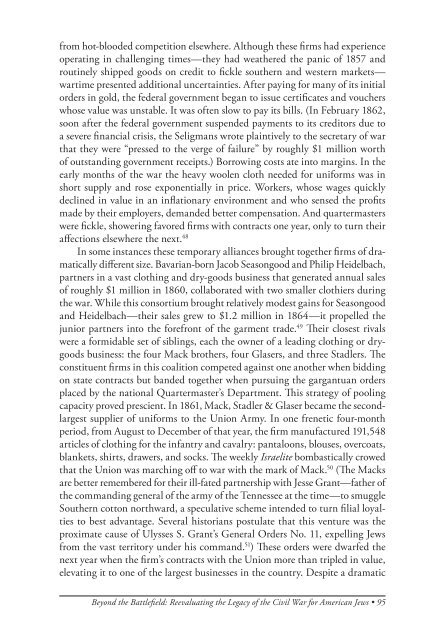American Jewish Archives Journal, Volume 64, Numbers 1 & 2
American Jewish Archives Journal, Volume 64, Numbers 1 & 2
American Jewish Archives Journal, Volume 64, Numbers 1 & 2
Create successful ePaper yourself
Turn your PDF publications into a flip-book with our unique Google optimized e-Paper software.
from hot-blooded competition elsewhere. Although these firms had experience<br />
operating in challenging times—they had weathered the panic of 1857 and<br />
routinely shipped goods on credit to fickle southern and western markets—<br />
wartime presented additional uncertainties. After paying for many of its initial<br />
orders in gold, the federal government began to issue certificates and vouchers<br />
whose value was unstable. It was often slow to pay its bills. (In February 1862,<br />
soon after the federal government suspended payments to its creditors due to<br />
a severe financial crisis, the Seligmans wrote plaintively to the secretary of war<br />
that they were “pressed to the verge of failure” by roughly $1 million worth<br />
of outstanding government receipts.) Borrowing costs ate into margins. In the<br />
early months of the war the heavy woolen cloth needed for uniforms was in<br />
short supply and rose exponentially in price. Workers, whose wages quickly<br />
declined in value in an inflationary environment and who sensed the profits<br />
made by their employers, demanded better compensation. And quartermasters<br />
were fickle, showering favored firms with contracts one year, only to turn their<br />
affections elsewhere the next. 48<br />
In some instances these temporary alliances brought together firms of dramatically<br />
different size. Bavarian-born Jacob Seasongood and Philip Heidelbach,<br />
partners in a vast clothing and dry-goods business that generated annual sales<br />
of roughly $1 million in 1860, collaborated with two smaller clothiers during<br />
the war. While this consortium brought relatively modest gains for Seasongood<br />
and Heidelbach—their sales grew to $1.2 million in 18<strong>64</strong>—it propelled the<br />
junior partners into the forefront of the garment trade. 49 Their closest rivals<br />
were a formidable set of siblings, each the owner of a leading clothing or drygoods<br />
business: the four Mack brothers, four Glasers, and three Stadlers. The<br />
constituent firms in this coalition competed against one another when bidding<br />
on state contracts but banded together when pursuing the gargantuan orders<br />
placed by the national Quartermaster’s Department. This strategy of pooling<br />
capacity proved prescient. In 1861, Mack, Stadler & Glaser became the secondlargest<br />
supplier of uniforms to the Union Army. In one frenetic four-month<br />
period, from August to December of that year, the firm manufactured 191,548<br />
articles of clothing for the infantry and cavalry: pantaloons, blouses, overcoats,<br />
blankets, shirts, drawers, and socks. The weekly Israelite bombastically crowed<br />
that the Union was marching off to war with the mark of Mack. 50 (The Macks<br />
are better remembered for their ill-fated partnership with Jesse Grant—father of<br />
the commanding general of the army of the Tennessee at the time—to smuggle<br />
Southern cotton northward, a speculative scheme intended to turn filial loyalties<br />
to best advantage. Several historians postulate that this venture was the<br />
proximate cause of Ulysses S. Grant’s General Orders No. 11, expelling Jews<br />
from the vast territory under his command. 51 ) These orders were dwarfed the<br />
next year when the firm’s contracts with the Union more than tripled in value,<br />
elevating it to one of the largest businesses in the country. Despite a dramatic<br />
Beyond the Battlefield: Reevaluating the Legacy of the Civil War for <strong>American</strong> Jews • 95
















